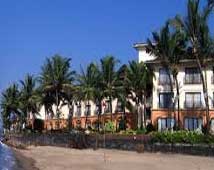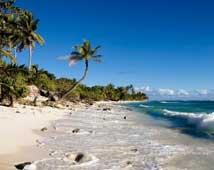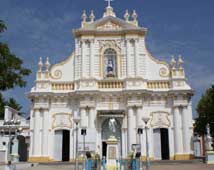
This is the capital of Goa, and the North Goa district. It is situated on the banks of the river "Mandovi". It is connected to the mainland by bridges.
History: The origin of the name Panaji or Panjim has many explanations. Some of them include it being the corrupted version of "Ponjy" said to mean "the land that never floods". The Portuguese called the city "Panjim" and after liberation it has seen its name changed to "Panaji".
It was a small fishing village with lots of coconut trees, creeks and fields. For centuries it remained so and was a neglected ward of Taleigao village with the only massive structure, the Adil Shah Fort by the Mandovi river. In 1632 the then Viceroy, Count de Linhares, Dom Miguel de Noronha built the 3.2km causeway linking Panjim with Ribandar village.
It exists even today and is known as the "Pointe de Linhares" and at the time it was constructed, was the longest bridge in existence. Around this time, against the backdrop of the decline of Old Goa, the idea of Panjim becoming the Capital of Goa slowly gained momentum.
On December 1 1759, the then Viceroy, Dom Manuel de Saldanha de Albuquerque, Count of Ega, shifted his residence from Panelim (near Old Goa) to Panjim. He moved to the newly re-modeled Adil Shah Fort, since known as "Idalcao's Palace" . The "Father of Panjim" is a title that is said to belong to the Viceroy, Dom Manuel de Castro de Portugal ( 1826-1835 ).
He began the process of slowly reclaiming land, initiated public projects, drainage systems and was also responsible for many of its government buildings and set the stage for Panjim to evolve into a magnificent city. By a royal decree on March 22, 1843 its status was elevated to a "City" and became the capital of Goa and was called "Nova Goa". The city was electrified in 1931. Over time it has undergone many changes under different administrations.

There are two old sections of the city existing today, one called "Fontainhas" and the other "Sao Tome". The hillock overlooking the city is called "Altinho".
Today, It is not only the state capital, but also an educational, commercial and cultural center of Goa. The Goa Medical College used to be situated here (since moved to Bambolim ) and so does the Goa College of Pharmacy, the Goa College of Art, and the Government Polytechnic. The Dhempe College of Arts and Sciences is situated in nearby Miramar. Some of the important parts of the city are discussed separately in the links below. It boasts of a cultural center-The Kala Academy, and a number of theater complexes.
The main transportation hub is across the "Pato bridge" over the Rua de Ourem creek at the Kadamba Bus Station . From this Bus station buses take off regularly to other Goan cities like Margao, Vasco da Gama, Mapusa , Ponda and other towns in Goa and to neighboring states. The nearest train station is Karmali, near Old Goa.
Typical of a Goan town, Panaji is built around a church facing a prominent square. The town has some beautiful Portuguese Baroque style buildings and enchanting old villas. The riverside, speckled with brightly whitewashed houses with wrought iron balconies, offers a fine view.
There are some fine government buildings along the riverside boulevard, and the Passport Office is especially noteworthy. In the 16th century, the edifice was the palace of Adil Shah (the Sultan of Bijapur). The Portuguese took over the palace and constructed the Viceregal Lodge in 1615. In 1843, the structure became the Secretariat, and today it is the Passport Office.
Trudge around town in the cobbled alleys to see quaint old taverns and cafés with some atmosphere, and practically no tourists. They are a good place to meet the local people.
The Church Square is a fine illustration of the awesome Portuguese Baroque style. The Church of the Immaculate Conception is easily one of the most elegant and picturesque monuments in Goa. Built in 1541 AD, atop a high, symmetrical, crisscrossing stairway, the church is a white edifice topped with a huge bell that stands in between two delicate Baroque style towers.

The Braganza Institute, houses the tiled frieze, which depicts the 'mythical' representation of the colonisation of Goa by the Portuguese. Fountainhas is a lovely old residential area amidst shady cobbled streets connecting red-tile-roofed houses with overhanging balconies, much like a country town in Spain or Portugal.
West of Fontainhas, the picturesque Portuguese quarter, the commercial centre's grid of long straight streets fans out west from Panjim's principal landmark, Church Square. Further north, the main thoroughfare, Avenida Dom Joao Castro, sweeps past the Head Post Office and Secretariat Building, before bending west along the waterfront.